Physics
NYA Mechanics
Examination
Part I
Exercise 1
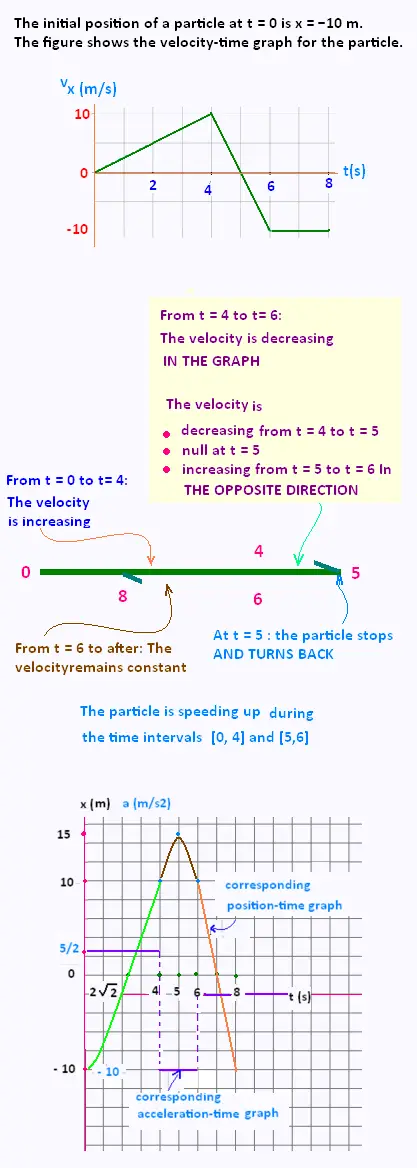
• (I) In the interval [0, 4] :a = rise/run = 5/2. The equation of motion is
x(t) = (1/2) (5/2) t2 - 10 = (5/4) t2 - 10
x(t) = (5/4) t2 - 10
• (II) In the interval [5, 6] : a = rise/run = - 10/1. The equation of motion is
x(t) = (1/2) (-10/1) t2 + vo t + xo.
Its derivative is:
v(t) = x'(t) = - 10 t + vo
We have v( t = 4) = 10 . So vo = 50 .
The continuity at the point (4, 10) yields:
10 = - 5 x 42 + 50 x 4 + xo . So xo = - 110
The equation of motion is
x(t) = - 5 t2 + 50 t - 110.
x(t) = - 5 t2 + 50 t - 110
• (III) In the interval [6, 8] : a = 0 and v = - 10 . The equation of motion is
x(t) = - 10 t + xo.
The continuity at the point (6, - 10) yields:
x(6) = - 10 x 6 + xo = x(t) = - 5 x 62 + 50 x 6 - 110 . So xo = 70
The equation of motion is
x(t) = - 10 t + 70.
x(t) = - 10 t + 70
Exercise 2
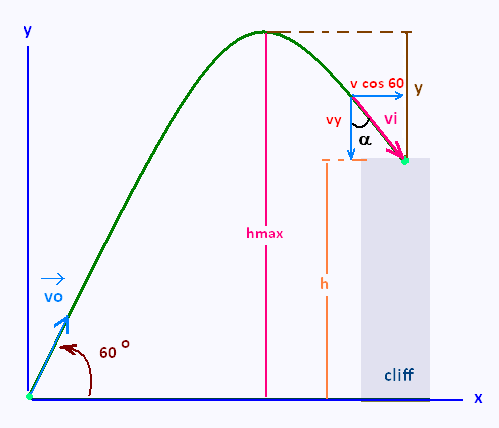
A ball is thrown towards a cliff with an initial speed of 30.0 m/s directed at an angle of 60.0 o
above the horizontal.
The ball lands on the edge of the cliff 4:00 s after it is thrown.
(a) What is the height of the cliff?
(b) What is the maximum height reached by the ball ?
(c) What is the ball's impact velocity ?
Answers
• (a) The equation of the motion is:
y(t) = (vo sin 60) t - (1/2) g t2 + 0
y(t) = 15 √3 t - 4.9 t2
h = y(4 s) = 15 √ (4) - 4.9 (4)2 = 25.5 m
h = 25.5 m
• (b) v2 - vo2 = 2 g hmax
(vo sin 60)2 - (0)2 = 2 g hmax
hmax = (vo sin 60)2 / 2 g =
(30 x √3/2))2/2 x 9.8 = 34.44 m
hmax = 34.44 m
• (c) The ball's impact velocity vi
yo = hmax - h = 34.44 - h = 25.5 m = 8.94 m
vy2 - vo2 = 2 g yo
vy2 - (0)2 = 2 g yo
vy2 = 2 g yo = 2 x 9.8 x 8.94
vy = 13.24 m/s
vi = (vy)v2 + (v cos 60o)2
vi2 = (13.24)2 + (30 x 0.5)2
= 20 m/s
vi = 20 m/s
tan α = v cos 60o/vy = 1.136
α = 48.6o
α = 48.6 o
Exercise 3
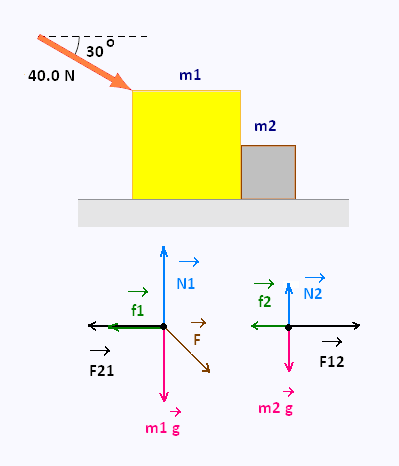
A 40:0N force pushes two masses, m1 = 8:00kg and m2 = 4:00kg, across a horizontal surface.
The force is directed 30o below the horizontal, as shown in thefigure.
The coefficient of kinetic friction between both masses and the surface is 0.150.
(a) Draw a free body diagram for each mass.
(b) What is the acceleration of the masses ?
(c) What is the force that m2 exerts on m1 ?
Answers:
(a) See the figure.
(b)
From the free body diagrams, we have:
F12 - f2 = m2 a
f2 = ν N2 = μ m2 g
and
F cos 30 - f1 - F21 = m1 a
f1 = μ N1 = μ(m1 g + F sin 30)
F12 - μ g m2 = m2 a (1)
F cos 30 - μ(m1 g + F sin 30) - F21 = m1 a (2)
F12 = m2 a + μ g m2
F21 = F cos 30 - μ(m1 g + F sin 30) - m1 a
According to the action-reaction principle : F12 = F21,
we write:
m2 a + μ g m2 = F cos 30 - μ(m1 g + F sin 30) - m1 a
Solving for a,
m2 a + m1 a = F cos 30 - μ(m1 g + F sin 30) - μ g m2
= F cos 30 - μm1 g - μF sin 30 - μ g m2
= F (cos 30 - μsin 30) - μ g (m1 + m2)
a (m1 + m2) = F (cos 30 - μsin 30) - μ g (m1 + m2)
a = F (cos 30 - μsin 30)/(m1 + m2) - μ g
a = F (cos 30 - μsin 30)/(m1 + m2) - μ g
a = 40 (√3/2 - 0.15/2)/(8 + 4) - 0.15 x 9.8
= 5 (√3 - 0.15)/3 - 0.15 x 9.8 = 2.637 - 1.47 = 1.17 m/s2
a = 1.17 m/s2
(c)
Using the relationship (1), we have:
F21 = m2 a + μ g m2 = m2 (a + μ g)
= 4(1.17 + 0.15 x 9.8) = 10.56 N
a = 10.56 N
Exercise 4
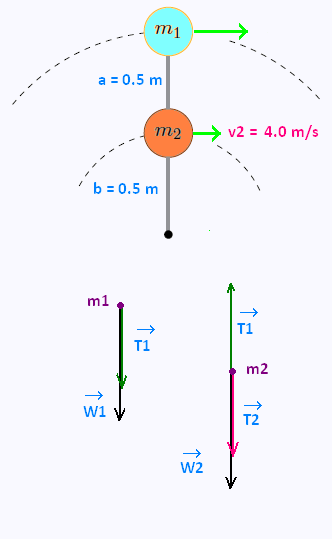
A ball of mass m1 = 4:00 kg is tied to another ball of mass m2 = 3:00 kg by a string of length
0:500 m. The two balls are swung in a vertical circle by a second string of length 0:500 m
connected to m2. As the balls rotate, the strings remain parallel. At the top if the circle, m2
is moving at 4:00 m/s.
(a) Draw a free-body diagram for each mass at this instant.
(b) What is the tension in the string connecting the two balls at this instant ?
(c) What is the tension in the string connecting m2 to the centre of the circle at this instant ?
Answers:
The strings a and b remain parallel, so m1 and m2 have the same angular velocity
ω.
We have:
v1 = ω x (a + b) = ω x (0.5 + 0.5) = ω
v2 = ω x b = ω x 0.5 = ω/2
v2 = 4 m/s. So v1 = 2 v2 = 2 x 4 = 8 m/s
v1 = 8 m/s
(a) See the figure.
(b)
From the free body diagram of the mass m1, we have:
T1 + m1g = centripetal force = m1v12/r. So
T1 = m1v12/r - m1g = m1(v12/r - g)
= 4(82/1 - 9.8) = 216.8 N
T1 = 216.8 N
Exercise 5
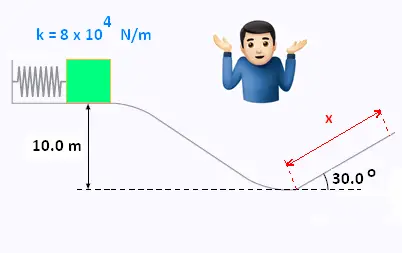
The spring shown in the figure is compressed 50.0 cm and is used to launch the block, which
has a mass of 100 kg. The surface is frictionless except for the final 30.0oo incline, where the
coefficient of kinetic friction is 0.150.
(a) What is the speed of the block when it reaches the valley below its starting point ?
(b) What distance does the block slide along the 30.0oo incline before stoppin g?
Answers:
(a) Total energy (at the top of the valley) = Total Energy (at the bottom of the valley)
0 + (1/2) k x2 + m gh = (1/2) mv2 + 0
v2 = (k/m) x2 + 2gh
= (8 x 104/100) (0.5)2 + 2 x 9.8 x 10.0 =
396
Then
v = 19.89 m/s
v = 19.89 m/s
(b)The energy conservation is:
(1/2) mv2 = (mg sin 30 + μ mg cos 30) x
(1/2g) v2 = (sin 30 + μ cos 30) x
So
x = v2/2g(sin 30 + μ cos 30) =
396 /(2 9.8 (1/2 + 0.15 √3/2)) =
396 /(9.8(1 + 0.15 √3)) = 396/12.35 = 32.1 m
x = 32.1 m
Exercise 6
6. A 1000 kg car, travelling east at 30.0 m/s, collides with a 3000 kg truck, travelling north. After
the collision, the vehicles stick together and the combined wreckage moves at 55.0 m/s north of
east.
(a) What is the speed of the truck before the collision ?
(b) What percentage of the initial kinetic energy of the system is lost during the collision ?
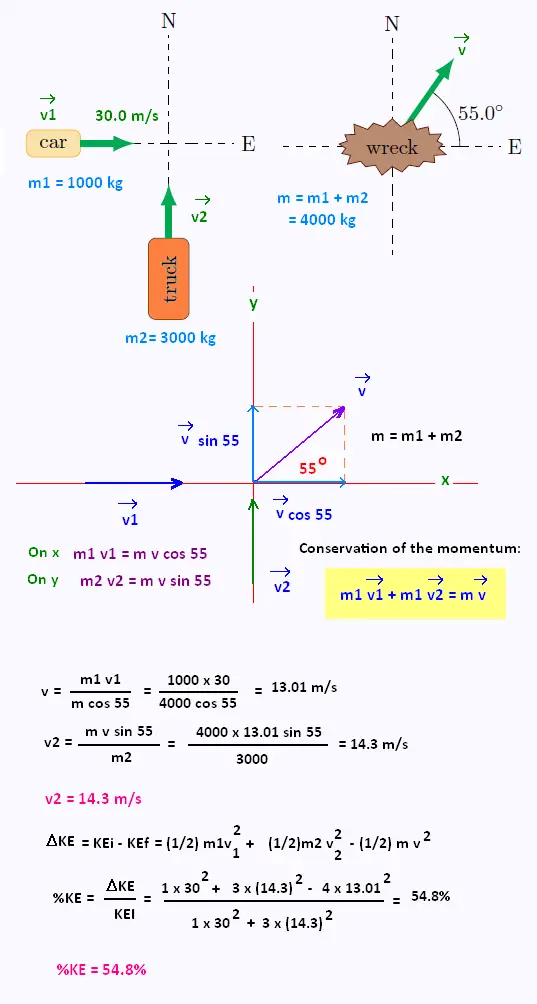
Exercise 7
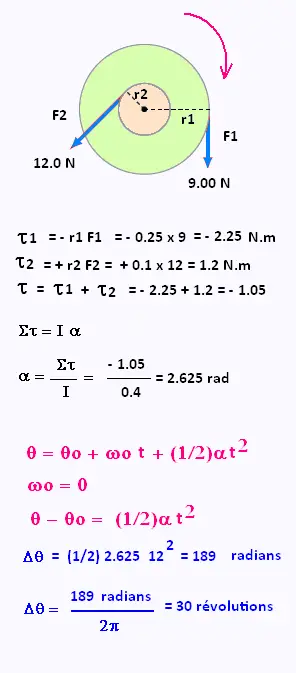
A solid wheel (made of two disks of different size) has a moment of inertia I = 0.400 kg.m2.
The wheel can rotate about a frictionless axle passing through its centre. A rope wrapped
around the outer radius of the wheel exerts a tangential force of magnitude 9.00 N at a distance
r1 = 0.250 m from the axle. A second rope, wrapped around the inner radius of the wheel
exerts a tangential force of magnitude 12.0 N at a distance r2 = 0.100 m from the axle.
(a) What is the torque due to each force and the net torque acting on the wheel ?
(b) What is the angular acceleration of the wheel ?
(c) If the wheel starts from rest, how many revolutions does it make in 12.0 seconds ?
Part II: Multiple Choice Questions

Complement on the question 8
The work done by a force is given by the area under
the force vs position graph, with signs included.
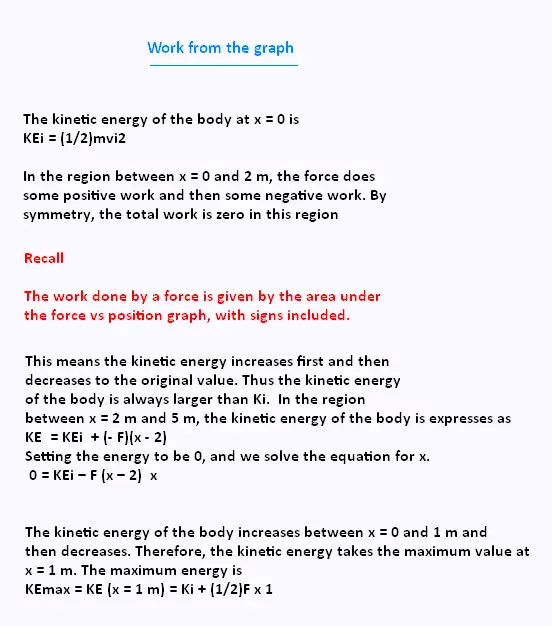
|